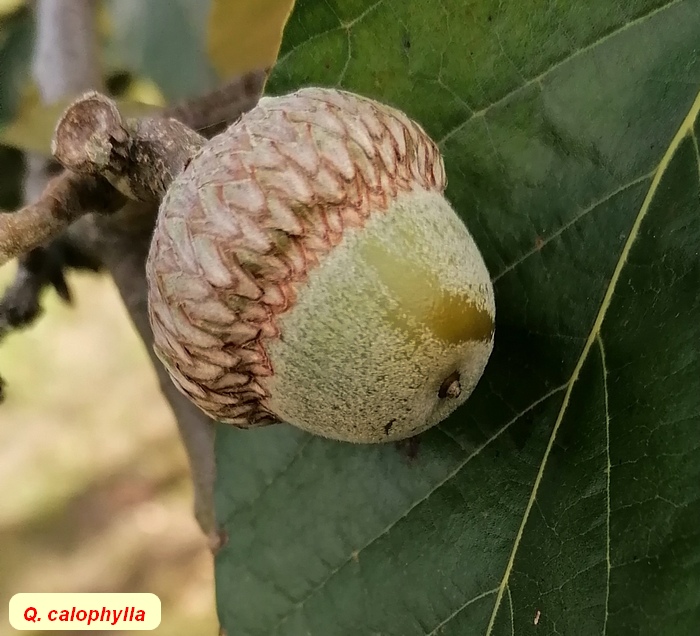| Quercus calophylla | |
| Author | Schltdl. & Cham. 1830 Linnaea 5: 79 1830. |
| Synonyms |
acuminata Martens & Galeotti 1843, not Sarg. alamo Benth. 1840 candicans Née 1801 Anales Ci. Nat. 3: 277 1801. candicans f. michoacana Trel. 1924 chimaltenangensis Trel. 1933 chimaltenangensis f. gemmata C.H.Muller 1937 flavida Liebm. 1854 Diagnosis here intermedia Martens & Galeotti 1843 umbrosa Endl. 1848 |
| Local names | encino
aguacatillo; encino de asta; ahuamextli; |
| Range | Mexico (Michoacan, Jalisco, Guerrero, Durango, Hidalgo, Mexico, Morelos, Nayarit, Puebla, Oaxaca, Sinaloa, Veracruz); Guatemala ; 1200 - 2700 m |
| Growth habit | 8-15 (-25) m
; trunk 20-60 cm diam.; |
| Leaves | 7-20 x 4-12
cm; thick, coriaceous to subcoriaceous; oboval to oblong-oboval; apex
aristate, obtuse or apiculate; base subcordate to truncate; margin flat,
cartilaginous, toothed apically (5-8 teeth pairs in the distal 1/2 or
1/4), sometimes entire (but always with aristae); lustrous dark-green,
slightly rough, almost glabrous above (sometimes with stellate hairs near
base and along the midvein); whitish tomentose beneath (yellow when dry),
tomentum made of sessile, stellate, 0.50 mm long, appressed hairs, and
simple glandular ones; 8-15 pairs of straight secondary veins, impressed
above, prominent beneath; epidermis bullate and papillose ; petiole 1-2
cm, hairy; |
| Flowers | staminate catkins 5-6 cm long, villous, 20-flowered; pistillate ones 2-5 flowered, 1.5-3 cm long; |
| Fruits | acorn 1.5-2 cm long, 1.5 cm wide; subglobose to ovoid, light brown, becoming glabrous; solitary or to 2-3, on a 5-15 mm long puberulent stalk; enclosed 1/2 to 3/4 by the cup; cup hemispherical, 1.5-2 cm wide, straight at the rim, with golden strigulose apical scales with ciliate margin ; maturing in 1 or 2 years; |
|
Bark, twigs and |
bark grey, furrowred into thick plates; twigs 2-3 mm diam., furrowed, with yellow pubescence first, becoming glabrous and dark red, with inconspicuous lenticels; buds obtuse, ovoid to long-ovoid, 3-6 mm, pubescent; stipules 1-1.5 cm long, soon or not deciduous; |
| Hardiness zone, habitat | a
little tender (zone 8); prefers calcareous soils; |
| Miscellaneous | --
A. Camus : n° 402; -- Sub-genus Quercus, section Lobatae, Series Erythromexicanae; -- In 2017, S. Valencia & al. has demonstrated that the type-specimen of this taxon (in the herbarium of Madrid, Spain), does not fit with the description; hence the name of Q. candicans is no more valid, and the Author thinks that the valid name Q. calophylla Schltdl. & Cham. 1830 must be used from now on. -- Resembles Q. fulva which is different in having shorter multiradiate hairs beneath (0.3 mm long), stitpitate fascicled hairs mixed with multiradiate ones below (versus only multiradiate in calophylla), the margin entire, the rim of the cup enrolled, the convexe limb. |
| Subspecies and varieties |
|
| Pictures |
|








